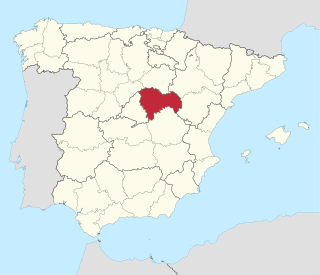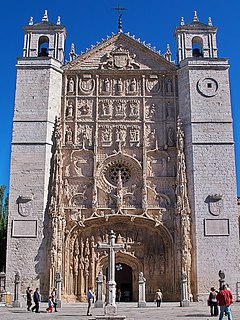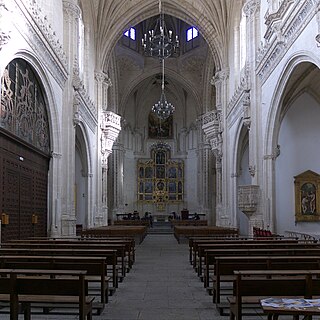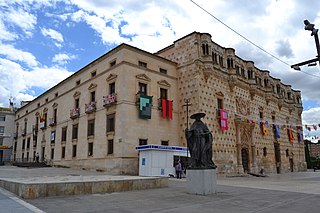
Guadalajara is a city and municipality in Spain, located in the autonomous community of Castilla–La Mancha. It is the capital of the Province of Guadalajara.

Guadalajara is a province of Spain, belonging to the autonomous community of Castilla–La Mancha. As of 2013 it had a population of 257,723 people. The population of the province has grown in the last 10 years. It is located in the centre of the Iberian Peninsula.

The Isabelline style, also called the Isabelline Gothic, or Castilian late Gothic, was the dominant architectural style of the Crown of Castile during the reign of the Catholic Monarchs, Queen Isabella I of Castile and King Ferdinand II of Aragon in the late-15th century to early-16th century. The Frenchman Émile Bertaux named the style after Queen Isabella.

Juan Guas was a Spanish artist and architect of French origin. He worked in a group of architects to create the Isabelline style. Born in Saint-Pol-de-Léon, he moved to Spain when he was young, and is often thought to have been Spanish. Among his notable buildings are:

Spanish Gothic architecture is the style of architecture prevalent in Spain in the Late Medieval period.

The Mendoza family was a powerful line of Spanish nobles. Members of the family wielded considerable power, especially from the 14th to the 17th centuries in Castile. The family originated from the village of Mendoza in the province of Álava in the Basque countries

Íñigo Lopez de Mendoza y Pimentel, 4th Duke of the Infantado was a Spanish nobleman. He was made a Knight of the Order of the Golden Fleece in 1546, the 193rd to receive that distinction. Duke of the Infantado is a title first granted in 1475 and was inherited upon his father's death in 1531. He was also 5th Count of Saldaña, 4th Marquess of Argüeso, 4th Marquess of Campóo, 5th Marquess of Santillana, 5th Count of Real de Manzanares, Señor de Mendoza, Señor de Hita, and Señor de Buitrago.

DonPedro de Alcántara Álvarez de Toledo y Salm-Salm, 13th Duke of the Infantado, was a Spanish politician and general.

The Marquisate of Cenete is a noble title first granted in 1491 by Queen Isabel I of Castile to Rodrigo Díaz de Vivar y Mendoza, First Count del Cid.

Diego Hurtado de Mendoza y Luna, 3rd Duke of the Infantado, nicknamed El Grande, was a Spanish noble.

Íñigo López de Mendoza was the second son of famous Spanish Poet and nobleman Íñigo López de Mendoza y Lasso de la Vega, marquis of Santillana, (1398–1458), and the cadet brother of Diego Hurtado de Mendoza, 1. duque of l'Infantado,, the brother also of Archbishop and Cardinal Pedro González de Mendoza,, named by his contemporaries "the third king of Spain".

The New Castle of Manzanares el Real, also known as Castle of los Mendoza, is a palace-fortress erected in the 15th century in the town of Manzanares el Real, next to the Santillana reservoir at the foot of Sierra de Guadarrama mountain range.

Duke of the Infantado is a Spanish peerage title that was granted to Diego Hurtado de Mendoza y Figueroa, son of Íñigo López de Mendoza, 1st Marquis of Santillana, by the Catholic Monarchs, Ferdinand II of Aragon and Isabella I of Castile, on 22 July 1475.

Íñigo López de Mendoza y Luna was a Spanish noble, the second Duke of the Infantado and third Marquis of Santillana.

Íñigo López de Mendoza y Mendoza was the 5th Duke of the Infantado from 1566 until his death in 1601.

Catalina Gómez de Sandoval y Mendoza (1616–1686) was the 8th Duchess of the Infantado, gaining the title after the death of her brother in 1657. She held the title until her own death in 1686. She also served in various important palace roles at the court of Charles II of Spain. She was also the Duchess Consort of Pastrana.

Rodrigo Díaz de Vivar y Mendoza, was a Spanish noble of the House of Mendoza. He was the firstborn son of the powerful Cardinal Pedro González de Mendoza and went on to become the 1st Conde del Cid and the 1st Marquis of Cenete, a title he held from 1491 until his death.

The Maratón de los Cuentos is an oral narration that takes place every year in the palacio del Infantado de Guadalajara (Spain) during the second or third weekend of June. The festival gather storytellers or cuentacuentos from around the world who narrate uninterruptedly stories over the weekend. Started in 1992, the Maratón de los Cuentos of Guadalajara is celebrated every year since then. It reached its twentieth edition in 2011 achieving 46 hours of storytelling without interruption. It brings together 200 volunteers who help develop more than 70 activities.

The Museum of Guadalajara is a State-owned museum in Guadalajara, Spain. Opened in 1838, it is the oldest provincial museum in the country. It features sections of Fine Arts, Archaeology and Ethnography. It is hosted at the Palacio del Infantado since 1973.













